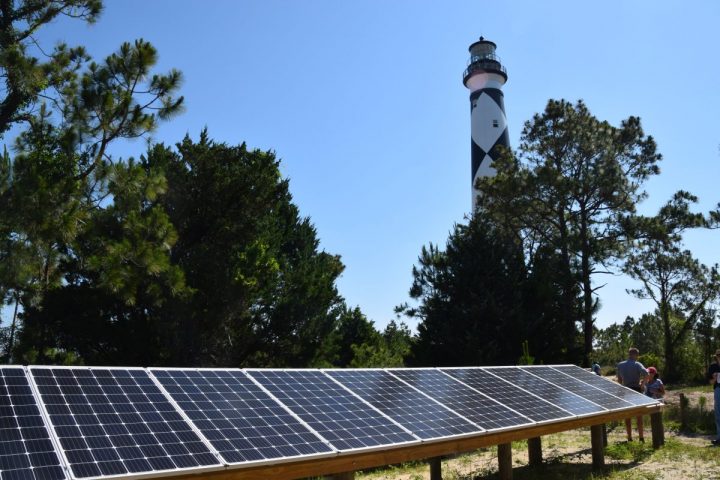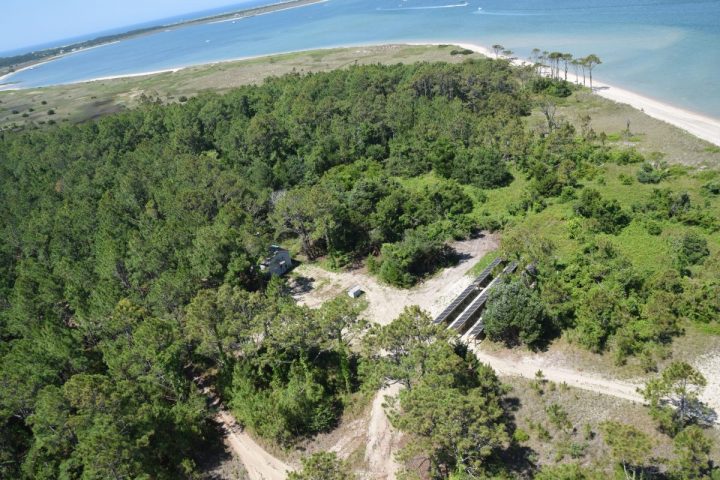
CAPE LOOKOUT NATIONAL SEASHORE – The National Park Service unveiled a new solar energy system during a ceremony on Tuesday, transitioning all of the park’s facilities to renewable energy in an effort to discontinue costly and inefficient energy sources the park has used in the past.
The photo-voltaic array is part of a series of transitions the park service staff is making toward modernization and energy efficiency, changes that also include an upgrade to the lighthouse’s beacon.
Supporter Spotlight
The morning ceremony held near the base of the Cape Lookout Lighthouse was led by Acting Cape Lookout Superintendent Mike Gauthier and U.S. Coast Guard Capt. Jerry Barnes, who expressed excitement about the project’s potential. Steve Sabol, a maintenance supervisor at the park who was involved in the planning and execution of the solar array, had the honor of flipping the switch to make the system go live.
The ceremony also marked the departure of the park’s acting Superintendent Mike Gauthier and the welcome of new acting Superintendent, Jeff West. In addition, the ceremony was held to announce the beginning of lighthouse climbing season, which had started earlier that day.

Sabol said the idea to make the switch to solar energy came from an assessment of the park’s former power source, an underwater cable that showed the aging system’s vulnerabilities. The park’s staff, he said, began considering what could happen if the park were to lose power.
“We started to determine what loss of power would mean for us,” Sabol said, “what it would mean to not be able to have the keeper’s quarters, to not be able to house volunteers, to not be able to provide potable water, and that was why we moved forward.”
The 18-kilowatt array unveiled this week was finished in March. It joins two other smaller solar arrays installed at the park during the last year. One of the two offsets power consumption at the Cape Lookout maintenance facility on Harkers Island, while the other, on top of the shelter on the island, powers the island’s main facilities.
Supporter Spotlight
The park worked with PowerHouse, a Newport-based electrical contracting company, to complete the project.
Together, these panels provide energy to all restrooms, keeper’s quarters, volunteer housing and water systems on the island. Sabol said a backup battery and generator system would prevent any lapse in power during overcast periods that keep the panels from producing at full capacity. He said the batteries would power the park for five days without any input from the panels.
The only facility on the island not powered by solar is the beacon in the lighthouse.
However, that is set to change by October. The Coast Guard has responsibility over the beacon because the light serves as a maritime navigational aid, and the Coast Guard plans to put in a light-emitting diode, or LED, as a replacement for the incandescent bulb. Capt. Barnes said the change would require less power, eventually allowing the beacon to be connected to the solar panels on the island.
The existing energy-intensive light consisting of two 1,000-watt DCB-24 aerobeacons are powered through a submerged cable from Harkers Island that was installed in by the U.S. Coast Guard in the 1980’s. The power from this cable was formerly used by the National Park Service to power the park’s facilities, along with diesel generators.

Barnes said the submerged cable is near the end of its expected life, and the Coast Guard had to make a decision. Switching the optic’s power source to solar and the light to an LED, he said, would significantly decrease maintenance costs while still providing for mariners’ needs.
“The submarine cable would cost the taxpayer $2-3 million (to replace), which over its service life would cost us to maintain the optic about $90,000 per year,” he said, “if we make this change it will really cost us less than $1,000 a year.”
Barnes said the upcoming changes to the lighthouse are exciting and practical.
“This system is so much easier to maintain, keep current, to bring in new panels should the need be, so it’s really the right thing to do,” he said.
Teresa Everett, a science education educator at the Core Sound Waterfowl Museum and Heritage Center on Harkers Island, also attended the ceremony. Everett said she sees the park’s shift toward solar energy as a positive change.
“I’m just excited to know the park service is kind of taking the view of the importance of solar energy,” she said, “and the fact of why not take advantage of something’s that’s right here for us?”
She said she plans to bring children and school groups to the park to look at the solar panels as a teaching tool.
The road to get the solar installation was a long one. The need to replace the current cable power system and light was recognized in 2009, Barnes said, leading to the agencies to consider other options and ask themselves important questions.
“How can we maintain the optic, maintain the grounds and work together to save the taxpayer money?” he said.
Sabol said a strong relationship and open communication between the park service and the Coast Guard was required to get to this point. Now that the solar panels are in place, he said, “everything seems to be moving pretty smoothly.”

Local Volunteers Sought
The National Park Service on the evening of May 16, the same day as the unveiling ceremony, invited the public to learn more about volunteer opportunities at Cape Lookout.
The meeting, which was held at the Core Sound museum, included a presentation from park officials and a question and answer session.
BG Horvat, the park’s chief of interpretation, said in a phone interview prior to the event that the park service is looking to find interested volunteers in the community in the hopes of expanding the park’s capabilities.
“We would like to have the lighthouse open seven days a week,” he said.
The park service works with more than 300 volunteers a year, Horvat said, but most are from other states and places. This outreach and program, which is in its beginning stages, needs local support.
Everett said anyone is welcome to be a volunteer, and that the park needs all kinds of assistance, from giving tours to helping at ticket booths.
“You don’t have to be a biologist to volunteer,” she said. “You don’t have to have a background, they’ll tell you everything that you need to know.”








